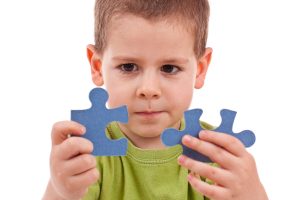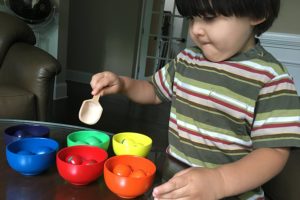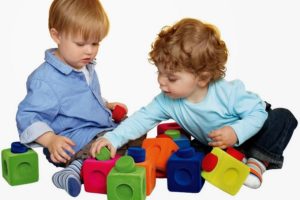In this post about gross motor activities, the following topics are covered:
- What are gross motor skills?
- Why are gross motor activities important? and
- How to get your toddler moving?
What Are Gross Motor Skills?
According to the CDC, gross motor activities and skills are the abilities to control the large muscles of our bodies. They are broken down a little more, as follows:
- Locomotor activities: this is movement from one spot to another, like running, walking, climbing, jumping, leaping, hopping, galloping, sliding, and skipping.
- Non-locomotor activities: this is movement in a stationary place, like pushing and pulling, bending, twisting, swinging, stretching, turning, swaying, rising, and falling.
- Manipulative skills: this is the act of moving objects in a variety of ways, by throwing, kicking, striking, and catching.
Why Are Gross Motor Activities Important?
We all know that exercise and physical activity is important for a healthy lifestyle, but by developing gross motor skills, our children gain strength and confidence in their bodies. It also develops their little bodies to do more complex skills in future activities, like playing sports.
Active play is a great idea for children of any age, but it’s especially important for toddlers and preschoolers. Gross motor activities help build their muscles, which in turn makes sure their bodies continue to develop properly. It also gets kids used to moving.
Gross motor skills are a key part in developing your child’s ability to follow instructions, work as a team, and prepare for precision work such as handwriting. Lots of activity can also help wear your little one out, ensuring they get a good afternoon nap in or helping them get a full night’s sleep.
In other words, gross motor activities are a big deal and pediatricians and professionals strongly recommend it.
Gross Motor Activities: How To Get Your Toddler Moving
Throwing and Kicking
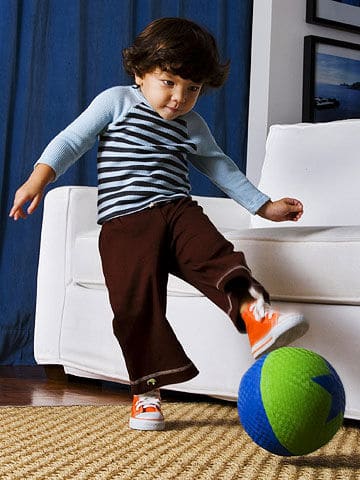
Get an early start on your child’s throwing arm by setting up a target in the yard for them to toss a beanbag or other soft projectile at. They’ll have fun being allowed to throw things for a change, and you’ll rest assured knowing your keepsakes are safely indoors! If you’re stuck inside, turn your trash can into a basketball hoop and crunch up some newspaper, or use some plastic lids as indoor Frisbees. Kicking is another important gross motor activity; if you have the space for it, start your little one on kicking a ball or other soft target.
Jumping
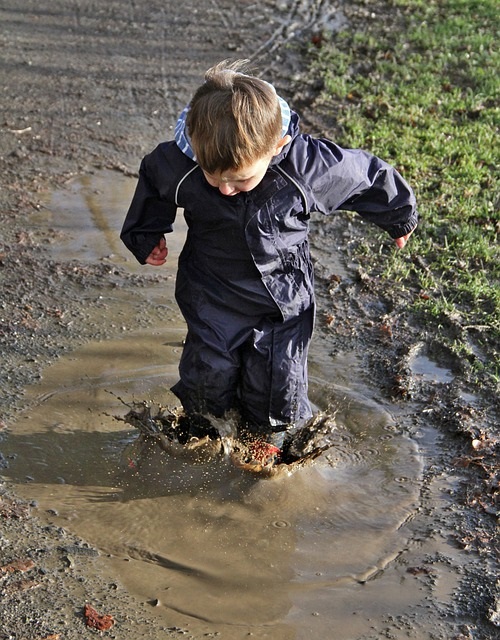 Jumping is a great gross motor activity, and there are a lot of ways to turn it into a fun game. If you want to start small, find a crash-proof space and see how far your child can jump. Something that requires your little one to hop from one spot to another, like hopscotch or a classic round of ‘the floor is lava,’ will get them moving and having fun. Use paper plates, clean cloth diapers, or other matching targets to set up a jumping course. There’s also the classic jumping rope!
Jumping is a great gross motor activity, and there are a lot of ways to turn it into a fun game. If you want to start small, find a crash-proof space and see how far your child can jump. Something that requires your little one to hop from one spot to another, like hopscotch or a classic round of ‘the floor is lava,’ will get them moving and having fun. Use paper plates, clean cloth diapers, or other matching targets to set up a jumping course. There’s also the classic jumping rope!![]()
Hide and Seek
 Obviously, hiding isn’t a motor activity of any sort, but the seeking is – and nothing says your little one has to be the one hiding! You can turn hide and seek into a scavenger hunt very easily by hiding a series of objects for your child to go and find. For added fun, consider turning off the lights and setting them loose with a flashlight to go hunting.
Obviously, hiding isn’t a motor activity of any sort, but the seeking is – and nothing says your little one has to be the one hiding! You can turn hide and seek into a scavenger hunt very easily by hiding a series of objects for your child to go and find. For added fun, consider turning off the lights and setting them loose with a flashlight to go hunting.
Skating and Balance
 Paper plates or socks can turn a linoleum or hardwood floor into the perfect skating rink. If your little one has very good balance, you can set them to walking along a specific line on the floor (you can make a line with masking tape, if your flooring pattern doesn’t already have one). Make sure to supervise your child especially closely during a skating or balancing session, though – the last thing you want is for them to slip and fall!
Paper plates or socks can turn a linoleum or hardwood floor into the perfect skating rink. If your little one has very good balance, you can set them to walking along a specific line on the floor (you can make a line with masking tape, if your flooring pattern doesn’t already have one). Make sure to supervise your child especially closely during a skating or balancing session, though – the last thing you want is for them to slip and fall!
Digging and Crawling
 Turn clean clothes and other household items into a ‘garbage bin’ with some of your child’s favorite toys scattered in the ‘trash.’ It’s good clean fun for the whole family, and will keep your little one moving and using their whole body in their active play. You can also string up a ‘spider web’ in the hallway, and set your child to getting past it without getting ‘stuck!’
Turn clean clothes and other household items into a ‘garbage bin’ with some of your child’s favorite toys scattered in the ‘trash.’ It’s good clean fun for the whole family, and will keep your little one moving and using their whole body in their active play. You can also string up a ‘spider web’ in the hallway, and set your child to getting past it without getting ‘stuck!’
Following a Path
 Whether walking or running, you can give your child a path through the house or a safe outdoor area to follow, and let them walk or run up and down it to their heart’s content. A string-based scavenger hunt with treasures hidden along the string’s path, a masking-tape road along the carpet, a tape or sidewalk-chalk maze, or even a path made up of different sensations under their hands and feet will hold your little one’s attention and keep them going.
Whether walking or running, you can give your child a path through the house or a safe outdoor area to follow, and let them walk or run up and down it to their heart’s content. A string-based scavenger hunt with treasures hidden along the string’s path, a masking-tape road along the carpet, a tape or sidewalk-chalk maze, or even a path made up of different sensations under their hands and feet will hold your little one’s attention and keep them going.
Combining Gross Motor Activities with Other Learning
Any of these activities can reinforce your little one’s grasp of numbers, letters, colors, and shapes. Just fold them into the design of the game.
For example, ask your child to:
- jump to a specific number;
- throw something at a specific letter;
- take art lessons outside and draw on the sidewalks;
- find several items of a specific color in the ‘trash bin’;
- do a scavenger hunt; or
- set your activity to music and get everyone moving.
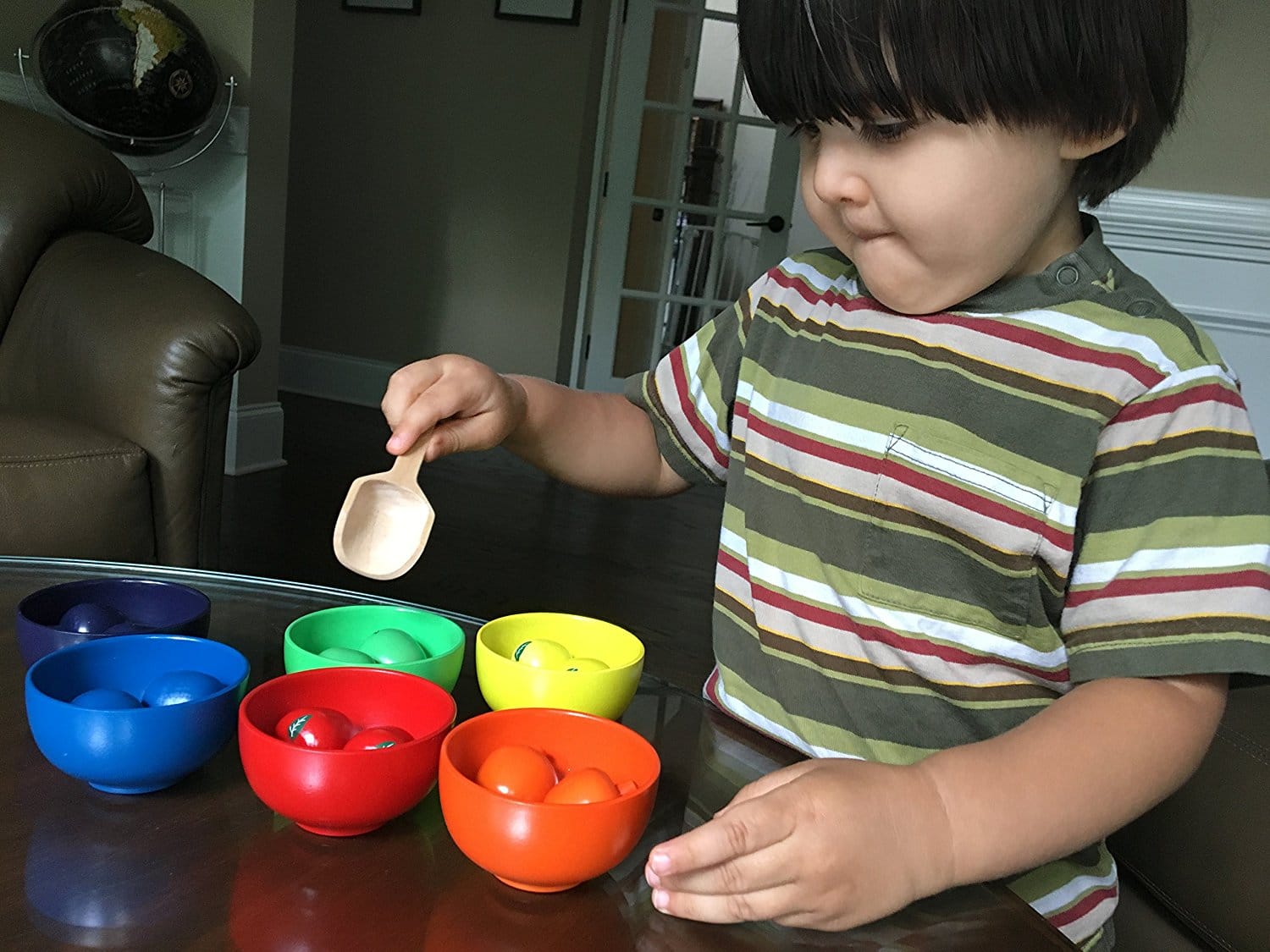
 Wooden Educational Toys for learning colors, counting, sorting and developing fine and gross motor skills.
Wooden Educational Toys for learning colors, counting, sorting and developing fine and gross motor skills.
Or how about combining gross motor, fine motor activities and learning into one activity? For example, if you have sorting toys like these wooden bowls and apples set![]() above, you could spread the apples around the room. A simple game like this can be an outstanding educational experience. Here are some of the skills your child could learn:
above, you could spread the apples around the room. A simple game like this can be an outstanding educational experience. Here are some of the skills your child could learn:
Gross motor activity: your toddler runs around the room, trying to find the apples. You could put obstacles in the way so that he/she may need to jump over or crawl under things;
Fine motor activity: as they find the apples, they scoop it up with the little shovel. They need to learn to balance as they walk the apples to the bowls;
Learning about sorting and matching: your toddler learns to match the apples with the corresponding bowl.
Learning colors: as they match it up, you could say something like, “you found the red apple.” This is an effective and playful way to learn colors;
Learn numbers and counting: as your toddler collects the apples, you could count them as they are deposited. As above, your toddler will be learning while playing.
Note From The Author
I have five children, which means I go to many well-visits at the pediatrician’s office.
I’m sure this is the case for you, but every time I go, I have to fill out a ton of forms. One question that I always see: “How much time does your child spend daily on physical activities.” These are the options:
- My child does not do physical activities
- 0-30 minutes per day
- 30 minutes to 1 hour per day
- 1-2 hours per day
This question always makes me wonder if I’m doing a good enough job, as a parent.
We usually try to reserve physical play time for after dinner, but with having 5 children and working, it is hard sometimes to make sure that happens, particularly if you have young kids. If you have older kids, you could tell them to “go play outside.” That’s not the case with younger kids because they need to be supervised. If you’ve been working all day and you feel drained, you may not feel up to it, every day.
This question bothered me a lot. I’ve spoken to our pediatrician about this and I explained that while we are generally a very active family, we cannot be active every single day. Sometimes we’re sick, or sometimes I just don’t have the energy. She said that I shouldn’t worry about it, and if we are active more than we are inactive, we should be fine.
RAISING A TODDLER? HERE ARE A FEW HELPFUL RESOURCES:
When your baby becomes a toddler, it’s a whole new world!

